|
|
 |
|
|
NATO Forces Spotlight: French Forces
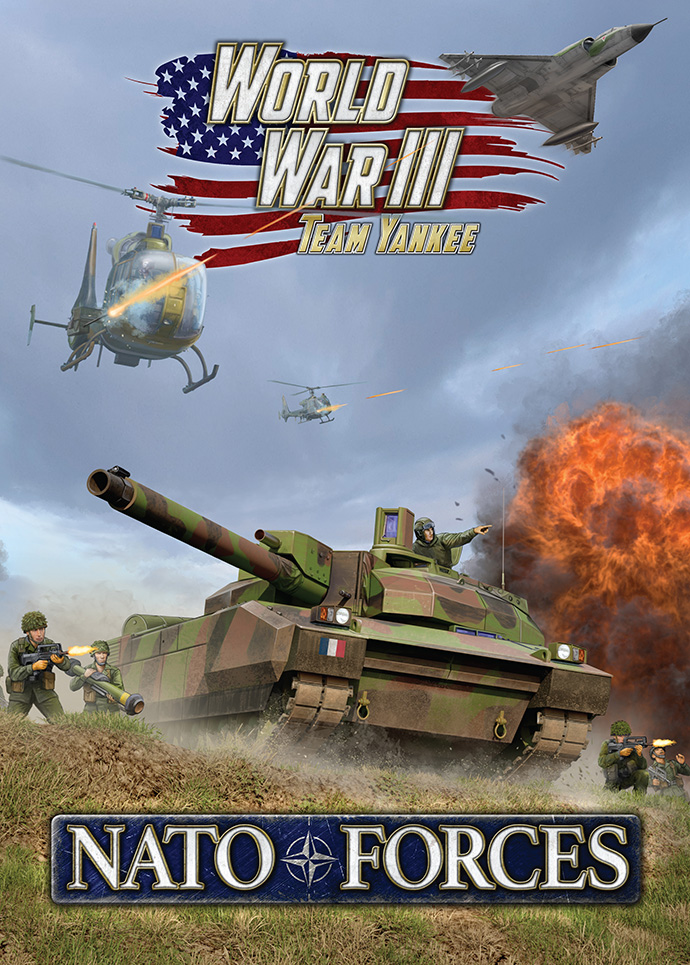 |
World War III: NATO Forces Design Notes
French Forces
with Wayne Turner
Back in 2018, we released Free Nations as our first multi-national book for Team Yankee. It added four more nations to the roster of forces with which to play. Free Nations started as an idea to add some of the forces of the smaller NATO nations but grew into something a little more when it was suggested we add the French. The project transformed from a loose idea to do some downloadable content, into a fully-fledged book with four Western nations (well, technically five if you choose to run your ANZACs as New Zealanders).
We have now further expanded this book into World War III: NATO Forces by expanding the forces and units available to the original four choices, and have also added a fifth nation, the Belgians.
|
|
So, what do you get?
Inside you will find five different forces from four NATO nations (Canada, France, Netherlands, and Belgium) and the closely allied ANZACs (a combined Australian and New Zealand force). It also includes three Scenarios featuring the Canadians, French and Dutch.
|
|
 |
|
The biggest nation represented in Free Nations and now World War III: NATO Forces is the French. They also have the most formations represented, with six. The French section starts with a background and a look at the battles of Capitaine Paul Durand’s Escadron Blindé (Armoured Squadron).
A French force can choose from six different formations and a great selection of support units. You can field a Leclerc Escadron Blindé, an AMX-30 Escadron Blindé, an AMX-10P Compagnie de Chasseurs (Light Infantry Company), a VAB Compagnie d’Infanterie (Infantry Company), an AMX-10 RC Escadron de Cavalerie (Cavalry Squadron), and a VBL Escadron d’Eclairage. The French have good Courage and Skill, average Remount, Rally, Counterattack and Assault, and fragile Morale. When well-supported they will fight well but are vulnerable when isolated.
|
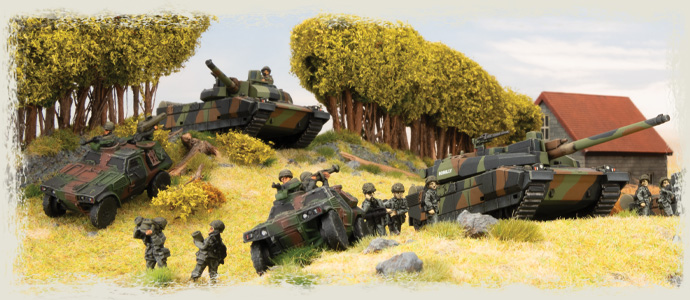 |
|
A new addition from Free Nations is the Leclerc Escadron Blindé. This tank formation is armed with the latest French main battle tank, the Leclerc. You can take an HQ with one Leclerc and up to four Leclerc Peloton Blindé (Armoured Platoons) of 2 or 4 Leclerc tanks. The second black box unit can be an AMX-30 Peloton Blindé instead, while the fourth unit can instead be an AMX-10P Section de Chasseurs (Light Infantry Section) if you choose.
This cutting-edge Leclerc battle tank is a big step up from the 1960s-era AMX-30. It is armed with a 120mm main gun. The gun has a range of 48”/120cm, ROF 2/2, Anti-tank 23, Firepower 2+ and is fitted with an Advanced Stabiliser and a Laser Rangefinder. It is also well-armoured with Front 22, Side 8, and Top 2 with Chobham Armour to protect it from HEAT weapons. It is equipped with Thermal Imaging for night fighting. The Leclerc is also fast and agile. This puts it in the same class as the later models of Leopard 2 and M1A1 Abrams.
|
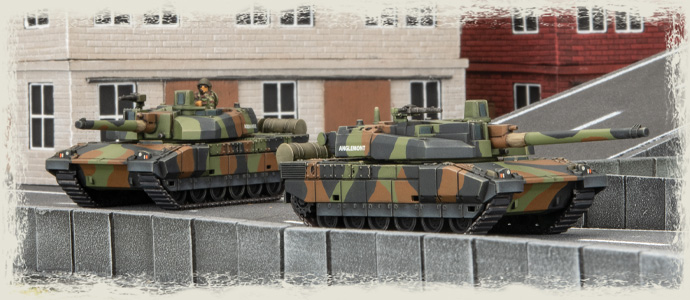 |
|
An AMX-30 Escadron Blindé is the French tank formation equipped with the AMX-30 tank. You can take an HQ with one AMX-30 and up to four AMX-30 Peloton Blindé (Armoured Platoons) of 3 or 4 AMX-30 tanks. The fourth unit can instead be an AMX-10P Section de Chasseurs (Light Infantry Section) if you choose.
The AMX-30 is a first-generation NATO tank like the West German Leopard 1 and started life as a rival design to the Leopard 1 when the Europeans were looking a designing one tank to fit all their needs. Eventually French broke off to complete their own tank which became the AMX-30. In the intervening years it has been upgraded to the AMX-30B2 with improved armour, targeting equipment, engine and transmission. Its French 105mm F1 gun fires NATO standard ammunition as well as indigenous French munitions. Its gun has Range 40”/100cm, halted ROF 2, moving ROF 1, AT 19 and FP 2+. The gun is Brutal (forcing unarmoured target to re-roll their saves), has a Laser-rangefinder (no +1 penalty To Hit as long-range) and Smoke. The AMX-30’s armour is Front 11, Side 4, and Top 1, giving it good protection against light weapons frontally, but like the Leopard 1, it must be wary of the more powerful 105mm to 122mm guns and better anti-tank missiles. The AMX-30 tank is a plastic kit that comes also with options to build the AMX AuF1 SP 155mm howitzer.
|
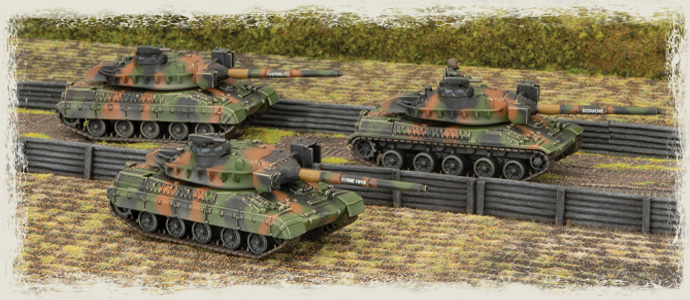 |
|
The AMX-10P Compagnie de Chasseurs is the French mechanised infantry formation mounting mech infantry in the AMX-10P tracked infantry fighting vehicle. The company consists of an HQ and 2 to 4 AMX-10P Section de Chasseurs, with the fourth unit being able to be an AMX-30 Peloton Blindé or Leclerc Peloton Blindé instead.
Each AMX-10P Section de Chasseurs consists of five FAMAS teams with AC-58 anti-tank grenades. These teams include the firepower of each squad’s 7.62mm NF-1 machine-guns giving them a Range 16”/40cm, Halted ROF 3, Moving ROF 2, AT 2 and (incorporating rifle grenades) FP 5+. For anti-tank defence, the AC-58 anti-tank grenades give them AT 13, FP 5+.
The section also includes 2x LRAC 89mm anti-tank teams with Range 16”/40cm, ROF 1/1, AT 17 and FP 4+. The LRAC is a reusable anti-tank rocket launcher. One of the LRACs can optionally be replaced with the disposable APILAS 112mm recoilless anti-tank weapon with Range 16”/40cm, ROF 1/1, AT 21 and FP 3+. Alternatively, all the LRACs can be replaced with the new Eryx short-range anti-tank guided missile. The Eryx is a French weapon and has been exported to NATO allies Canada and Norway as well. The Eryx, though guided, can still be used in Assault defensive fire, but like other guided weapons still cannot be used in the subsequent Assault combat. This weapon has a range of 16”/40cm, but no minimum range. It has a massive anti-tank of 24 and a Firepower of 4+.
|
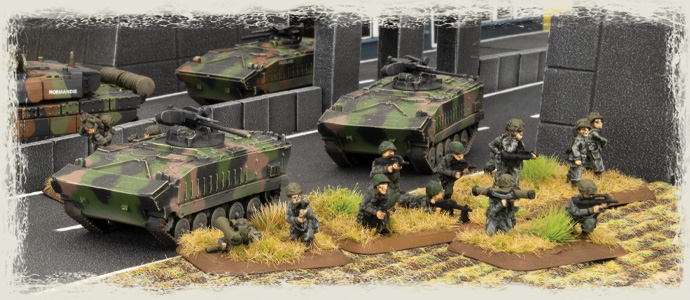 |
|
The section's anti-tank capability can be further enhanced with the addition of two Milan missile teams. These can be either Milan or Milan 2. The Milan is a very effective medium-range anti-tank guided missile with a Range 8”/20cm to 36”/90cm, Halted ROF 1, AT 21 and FP 3+. The Milan 2 improves on this with Anti-tank 24. Whichever type of Milan you choose, any units in your force with that choice must take the same type. These teams come with their own AMX-10P transport.
All of these teams are transported in the AMX-10P infantry fighting vehicle. The AMX-10P is part of a universal design program that also produced the AMX-10 RC armoured car (see below). It is armoured for protection against light weapons (Front 2, Side 1, Top 1) and is armed with a 20mm gun for fire support (Range 20”/50cm, ROF 3/2, AT 6, FP 5+, Anti-helicopter) and can mount a Milan missile. Each section has four vehicles. The AMX-10P is a plastic kit.
|
|
The fourth formation available to the French is the Escadron de Cavalerie. This formation has undergone a few changes since Free Nations. In World War III: NATO Forces this Formation contains an HQ with a command 4x4 VAB wheeled armoured personnel carrier, 2 to 4 AMX-10 RC Peloton de Cavalerie (Cavalry Platoons), up to four VBL Patrouille d’Eclairage de Cavalerie (Cavalry Recon Patrol), and a VAB Section d’Infanterie.
Each AMX-10 RC Peloton de Cavalerie consists of three to four AMX-10 RC armoured cars. As the name suggests, the AMX-10 RC shared some of the same design and mechanical components as the AMX-10P IFV but differed in a couple of significant ways. The AMX-10 RC is a 6x6 wheeled armoured car mounting a 105mm gun-armed turret. Unlike most multi-wheeled vehicles, the AMX-10 RC does not use conventional steering, but like a tracked vehicle it steers by rotating the wheels on each side at different speeds. This vehicle has a couple of unique features like its 105mm F2 gun which is a slightly shorter version of the 105mm F1 gun found in the AMX-30 tank. Its range is a little shorter at 36”/90cm, ROF 2/1, AT 19 and FP 2+. It is Brutal, has a Laser-rangefinder, and fires HEAT and Smoke ammunition. As an armoured car, it is lightly armoured (Front 2, Side 1, Top 1), but has some excellent Dash speeds (Cross Country 18”/45cm, Road 40”/100cm). You can also take this unit just as part of your support rather than get a whole formation. Each unit uses the Scout rules.
|
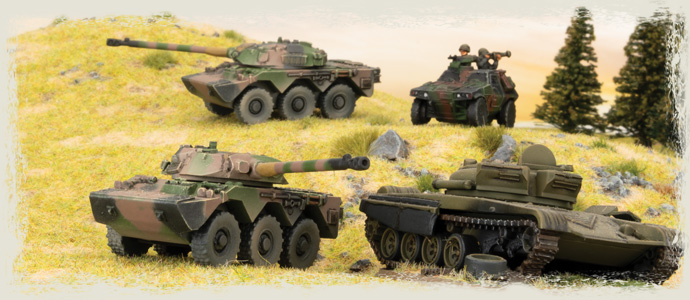 |
|
While the AMX-10 RC armoured cars provide the firepower, the actual reconnaissance is carried out by the VBL Patrouille d’Eclairage de Cavalerie. These units are equipped with three VBL, or Véhicule Blindé Léger (Light Armoured Vehicle), an armoured jeep built specifically for the role. The VBL mounts a 7.62mm machine-gun and the crew can carry APILAS or Eryx anti-tank weapon onboard for anti-tank protection.
The Escadron d’Eclairage is a new formation, it also features the VBL. It contains an HQ of two VBL, a three to nine VBL Patrouille d’Eclairage, and one VBL Groupe de Antichar Milan. In this formation, each VBL Patrouille d’Eclairage is equipped with two VBL patrol vehicles. The VBL Groupe de Antichar Milan has three VBL jeeps armed with either Milan or Milan 2 anti-tank guided missiles. Because a division only has one of these squadrons, your French force can only have one of these formations.
|
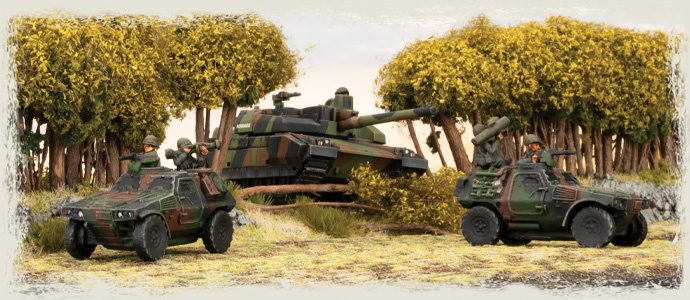 |
|
The final French formation available is the VAB Compagnie d’Infanterie. The VAB Compagnie d’Infanterie consists of an HQ and 2 to 4 VAB Section d’Infanterie, a 120mm Peloton de Mortier, a Milan Section Antichar, an AMX-30 Peloton Blindé or Leclerc Peloton Blindé or AMX-10 RC Peloton de Cavalerie, and a VAB T20 Section d’Appui-Feu.
Each VAB Section d’Infanterie is larger than the Chasseurs, with seven FAMAS teams with AC-58 anti-tank grenades, and two LRAC 89mm anti-tank teams. Options include exchanging one LRAC for an APILAS, or replacing them with Eryx missiles, and adding a Milan or Milan 2 team. Each section comes with four VAB 4x4 wheeled armoured personnel carriers. The VAB is armoured against light weapons (Front 2, Side 2, Top 1) and is armed with a 12.7mm AA MG. It can also optionally mount a Milan missile. Up to two of your VABs can be replaced with VAB T20 transports that mount a 20mm cannon in a roof-mounted turret.
|
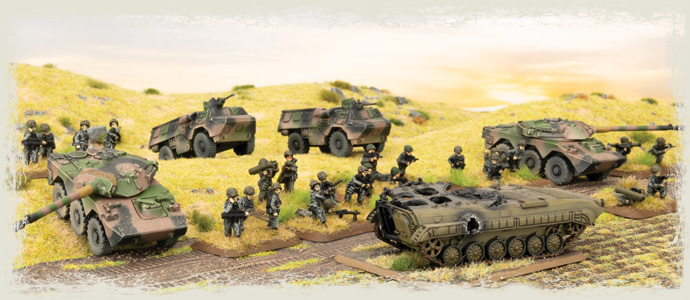 |
|
The formation can also take a Milan Section Antichar (Milan Anti-tank Section) with up to eight Milan or Milan 2 missile teams and four VABs to transport them.
Further fire support comes from the 120mm Peloton de Mortier. This has up to six towed 120mm mortar teams. These provide indirect fire support as well as a Smoke Bombardment. They are towed by VAB transports but can be replaced by AMX-10P infantry fighting vehicles.
The VAB T20 Section d’Appui-Feu (Fire Support Section) provided direct fire support with its VAB turret-mounted 20mm guns. These have a range of 20”/50cm, ROF 3/2, Anti-tank 6, Firepower 5+ and can also fire at Helicopters.
|
|
Support
The French have an excellent selection of support units. For additional anti-tank support, they have the VAB Mephisto Peloton Antichar armed with the VAB Mephisto missile vehicles. This vehicle mounts powerful HOT missiles on an elevating turret on the VAB APC. It uses the Hammerhead rule and can remain Gone to Ground while shooting. The HOT missile has a Range 8”/20cm to 48”/120cm, ROF 1, AT 23 and FP 3+ and uses the HEAT and Guided rules.
Like many other NATO nations, the French adopted the American M270 MLRS multiple rocket system. The Lance-roquettes Multiples (LRM), as called by the French, can target positions out to 120”/300cm with its Salvo artillery template. Optionally the M270 LRM can be further armed with Minelets.
The French also have a sophisticated new artillery system in the form of the AMX AuF1 self-propelled howitzer. These come in batteries of up to five guns. Mounted in a turret, the 155mm howitzer is fitted with an Autoloader which reduces the score required To Hit by 1. The 155mm howitzer can shoot artillery bombardment out to 104”/260cm, more than enough to cover most Team Yankee battlefields. This kit is all plastic and comes within the same box as the AMX-30 tank, as both weapons are based on the same hull.
|
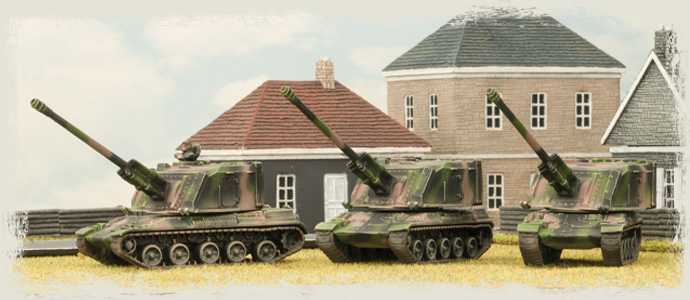 |
|
The French also have two air defence options in the AMX Roland surface-to-air missile vehicle and the AMX-13 DCA anti-aircraft tank. The AMX Roland mounts the excellent Roland SAM system on a modified AMX-30 tank hull. The Roland AA missiles have Range 56”/140cm, ROF 3, FP 4+ and use the Guided AA rule.
The AMX Rolands role can be backed up with the Mistral Groupe SATCP infantry attachment of Mistral man-portable ground-to-air missiles. The Mistral SATCP team has a good Range of 56”/140cm, ROF 3/- and Firepower 4+ and is a Guided AA weapon.
The AMX-13 DCA mounts Twin 30mm AA guns on an AMX-13 light tank hull. The guns have a Range 24”/60cm (36”/90cm at aircraft using Radar), ROF 5/3, AT 7, and FP 5+.
|
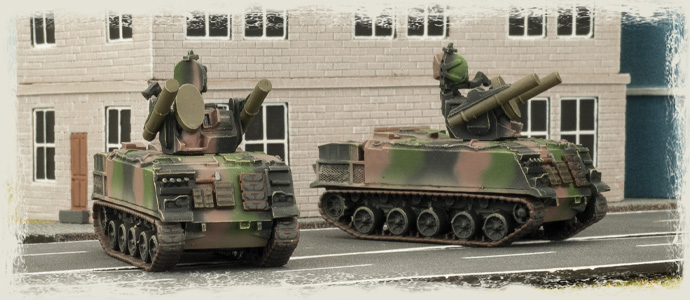 |
|
The French have three aircraft choices, two types of Gazelle helicopters, and a Mirage 5 strike aircraft. The first Gazelle option is armed with HOT missiles and uses the Hunter-killer rule, allowing the helicopter to be concealed by Tall Terrain and remain Gone to Ground while moving. The second Gazelle unit mounts a 20mm gun and provides protection for the Gazelle HOT helicopters by suppressing enemy anti-aircraft units. To aid them in this role they use the Gun Slinger rule, which allows them to use Tall Terrain as concealment, remain Gone to Ground while moving, and fire their weapons before enemy AA units shoot at them.
Both Gazelle helicopters can be made with the new Gazelle helicopter plastic kit.
The Mirage 5 Patrouille de Chasse (Hunting Patrol) is equipped with up to four Mirage 5 strike aircraft armed with BLG-66 cluster bombs (Range 6”/15cm, SALVO, AT 8, FP 3+) and 30mm auto-cannons (Range 8”/20cm, Moving ROF 3, AT 7, FP 5+, Anti-helicopter).
|
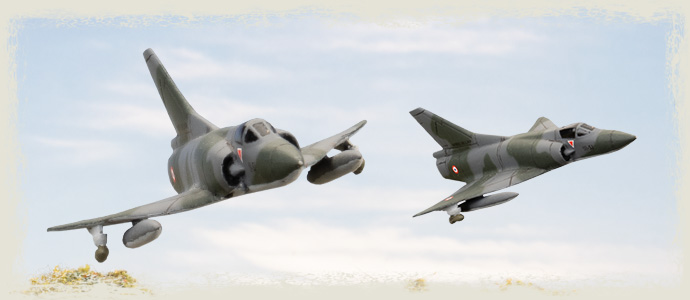 |
|
The French can also take a NATO allied formation as part of their force.
|
|
Bonus Content
At the back of World War III: NATO Forces you will also find two pages on NATO Missile Upgrades. This section allows you to field West German, British, and American forces with the newer versions of anti-tank guided missiles (this will also be available as a PDF download).
West Germans can take Milan 2 and HOT 2, the British can take Milan 2, and the Americans can take M47 Dragon 2 missiles.
The Milan 2 increases the missile’s anti-tank to 24.
The HOT 2 increases the missile’s anti-tank to 24
The M47 Dragon 2 increases the missile’s anti-tank to 21.
Like many of these upgrades, where a Unit has a choice, all Units in the Force must take the same type.
|
|
Scenarios
As well as the five forces, World War III: NATO Forces also includes three scenarios featuring Canadian, Dutch and French forces. These can be played with the suggested forces, or you can use the suggested points to field alternative forces in the scenarios. The scenarios can be run as a linked campaign, or as individual one-off games.
|
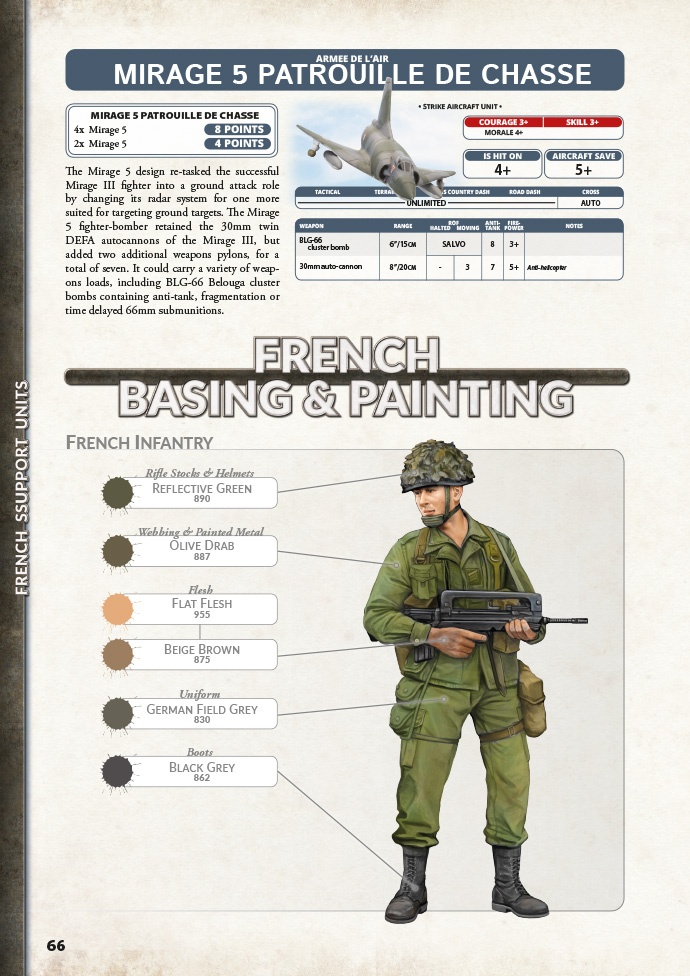 |
Painting and Models
The final sections in each nation’s part of World War III: NATO Forces include painting and basing guides. This includes armour painting for Yellow Olive and NATO 3-colour, infantry painting guides for Australians, French, Canadians, Dutch, and Belgians, and aircraft colour guides. Basing guides for the teams of World War III: NATO Forces infantry forces.
After each nation section, there is a comprehensive guide to the models of World War III: NATO Forces, listing all the great new boxes and packs that will be coming out for the Canadians, French, Dutch, ANZACs, and Belgians.
It’s a great new book with plenty of forces to choose from, whether you a looking for a new NATO force to field or looking at adding a new formation to a current NATO force.
~Wayne
|
|
|
|